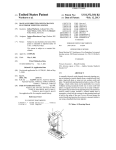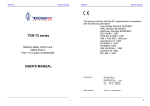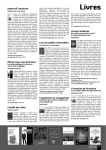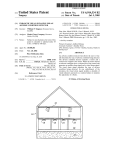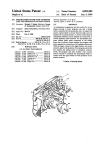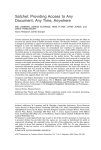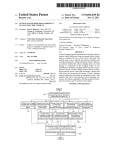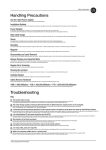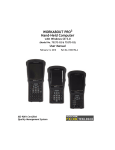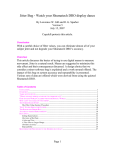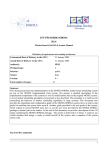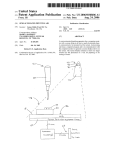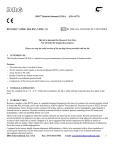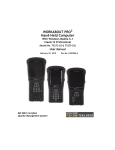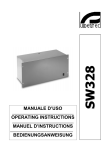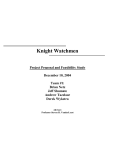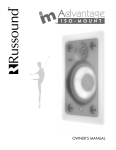Download Unintended motion control for manually directed multi
Transcript
US008367022B2 (12) United States Patent Warhurst et a]. (10) Patent N0.: (45) Date of Patent: US 8,367,022 B2 Feb. 5, 2013 UNINTENDED MOTION CONTROL FOR MANUALLY DIRECTED MULTI-CHANNEL ELECTRONIC PIPETTOR 5,116,180 A 5/1992 Fung et al. 5,895,630 A * 6,270,726 B1 * 4/1999 8/2001 6,360,792 B1 3/2002 GanZ et al. (75) Inventors: Julian Warhurst, Ashland, MA (US); 6,627,446 B1 * 6,637,473 B2 * (54) Richard Cote, Bolton, MA (U S) 6,982,063 B2 (73) Assignee: Integra Biosciences Corp., Hudson, NH (Us) (*) Notice: Subject to any disclaimer, the term of this patent is extended or adjusted under 35 9/2003 10/2003 Roach et a1. .................. .. 436/43 GanZ et al. .................. .. 141/130 l/2006 Hamel et al. 7,105,132 B2 * 7,135,146 B2 * 9/2006 11/2006 Shumate et al. ............ .. 422/510 Johnson et a1. ............. .. 422/521 7,540,205 7,662,343 7,662,344 8,033,188 6/2009 2/2010 2/2010 10/2011 Nelson et a1. Mathus et al. Mathus et al. Kalmakis et al. B2 B2 B2 B2 2001/0005489 A1 * 6/2001 U.S.C. 154(b) by 0 days. Roach et a1. .................. .. 422/99 (Continued) (21) Appl. N0.: 13/099,953 (22) Filed: Skaborn et al. ............. .. 422/509 Tyberg et al. ............... .. 422/509 FOREIGN PATENT DOCUMENTS WO May 3, 2011 2009/130318 10/2009 OTHER PUBLICATIONS (65) Prior Publication Data US 2011/0268628 A1 Nov. 3, 2011 Related US. Application Data Rainin Pipetting 360°Simultaneous 96-Well pipetting, Fast manual benchtop system, 2009 Rainin Instrument, LLC, PB-210 LIQ RevB, 2 pages. (Continued) (60) Provisional application No. 61/330,545, ?led on May 3, 2010. Primary Examiner * Brian R Gordon (51) Int. Cl. B01L 3/02 (52) (2006.01) US. Cl. ...... .. 422/509; 422/511; 422/516; 422/522; 422/524; 422/525; 73/863.32; 73/864; 73/864.01; 73/864.11; 73/864.24; 73/864.25 (58) (74) Attorney, Agent, or Firm *Andrus, Sceales, Starke & SaWall, LLP Field of Classi?cation Search ................ .. 422/ 509, 422/511, 516, 519522, 524525, 63*681; 73/863.32, 864, 864.01, 864.11, 864.13, 73/864.16*864.21, 864.25, 864.31 See application ?le for complete search history. (56) References Cited U.S. PATENT DOCUMENTS 4,478,094 A * 4,555,957 A * 10/1984 12/1985 Salomaa et a1. ......... .. 73/863.32 Frankel et a1. ........... .. 73/864.14 (57) ABSTRACT A manually directed, electronic multi-channel pipettor uses servo controlled motors to drive a carriage and pipetting head in response to a user’s manipulation of a control handle. The pipetting head include an array of tip ?ttings, e.g. 96. The system includes a check processor to avoid unintended motion in case of system faults or crashes. The system requires substantial force to attach the array of tips, and therefore includes controls that require both of the user’s hands be occupied during the tip attachment process. 8 Claims, 13 Drawing Sheets US 8,367,022 B2 Page 2 US. PATENT DOCUMENTS 2001/0048899 A1 * 12/2001 Marouiss et a1‘ """""" " 422/100 2005/0249635 A1 11/2005 Okun et al. OTHER PUBLICATIONS Rainin Pipetting 360° Liquidator 96, Manual benchtop pipetting . . 2006/0048846 A1 3/2006 Roenneburg system, 2000 Ra1n1n Instrument, LLC, 9920-360 Rev. B, 16 pgs. 2007/0221684 A1 2009/0074622 A1 9/2007 Steinbrenner et a1‘ 3/2009 Kalamakis et a1‘ CyB1-Well P1pettor User Manual, Release Sep. 2008, 88 pgs. Thermo Scienti?c Matrix Hydra II, Product Speci?cation, 2008 2009/0226344 A1* 2009/02745g7 A1 9/2009 Nishida et a1. ................ .. 422/67 1 1/2009 ButZ et a1‘ Thermo Fisher Scienti?c, Inc» 2 PgS~ Thermo Scienti?c Matrix PlateMate 2x3, Product Speci?cation, 2011/0039709 A1* 2/2011 Lips et a1. ....................... .. 506/7 2007 Thermo Fisher Scienti?c, Inc‘, 2 pgs 2011/0209564 A1 * 9/ 2011 Von Beichmann Thermo Scienti?c Matrix PlateMate Plus, Product Speci?cation, et a1. ........................ ,, 73/864,01 2011/0268627 A1 11/2011 Warhurst et a1. 2011/0296931 A1 12/2011 Warhurst 2007 Thermo Fisher Scienti?c, Inc., 2 pgs. * cited by examiner US. Patent Feb. 5, 2013 58 Sheet 1 0f 13 US 8,367,022 B2 ,9? 28 20 FIG. 1 Q 16 US. Patent 54 56 58 24 Feb. 5, 2013 Sheet 2 0f 13 US 8,367,022 B2 US. Patent Feb. 5, 2013 Sheet 3 0f 13 US 8,367,022 B2 56 58 12 32 US. Patent Feb. 5, 2013 Sheet 4 0f 13 US 8,367,022 B2 30 22 FL IW 74FL 76 I?_ f 102 \ 100 ) 8O -3 US. Patent Feb. 5, 2013 FIG. 5 Sheet 5 0f 13 US 8,367,022 B2 24 US. Patent Feb. 5, 2013 Sheet 7 0f 13 US 8,367,022 B2 60 AW 60 204 FIG. 8 US. Patent Feb. 5, 2013 Sheet 8 0f 13 US 8,367,022 B2 60 204 _/ 22 FIG. 9 %\ 14 /2s FIG. 10A /74'1O8 2 O 8A M HamEDWMPR wKm Lwm F0 C B AI PERMANENT T N MAGNET MOTOR m 02m HALL EFFECT BIPOLAR SENSORS 2 MOTOR DIRECTION AND POWER LEVEL HALL EFFECT _ SIGNALS _ COMUTATION LOGIC POWER 3 PHASE MOTOR DRIVER I TO MOTOR WINDINGS US. Patent Feb. 5, 2013 US 8,367,022 B2 Sheet 10 0f 13 I READ 3 HALL INPUT PINS INTO ONE BYTE FAULT CONDITION EXISTS 7 WRITE INVALID HALL CODE TO OUTPUT PINS WRITE BYTE TO 3 OUTPUT PINS I I GOTO LOCKOUT STATE UNTIL REBOOTED FIG. 11 SAFETY SWITCH ACTIVATED MEASURE MOTOR TRAVEL USING ENCODER ZERO THE POSTION COUNTER TRAVEL YES GOTO LOCKOUT STATE UNTIL REBOOTED FIG. 13 US. Patent Feb. 5, 2013 CLOCKWISE ENCODER COUNT DETECTED ? Sheet 12 0f 13 US 8,367,022 B2 YES I ADD 3 TO ERROR COUNTER NO COUNTER CLOCKWISE ENCODER COUNT DETECTED YES SUBTRACT 3 FROM ERROR COUNTER NO CLOCKWISE HALL MOTION DETECTED .7 YES I SUBTRACT 250 FROM ERROR COUNTER NO COUNTER CLOCKWISE HALL MOTION YES I ADD 250 TO ERROR COUNTER ENCODER ERROR COUNT YES > +/ —500 I ? NO GOTO LOCKOUT STATE UNTIL REBOOTED FIG. 14 US. Patent Feb. 5, 2013 ENCODER MEASURED SPEED >MAX ALLOWED 7 Sheet 13 0f 13 US 8,367,022 B2 L GOTO LOCKOUT STATE UNTIL REBOOTED US 8,367,022 B2 1 2 UNINTENDED MOTION CONTROL FOR MANUALLY DIRECTED MULTI-CHANNEL ELECTRONIC PIPETTOR using a levered mechanical mechanism. Because the system is fully manual, it lacks the ability to program precise proto cols and liquid transfer amounts. On the other hand, elec tronic hand-held pipettors and automated liquid handling sys tems can be programmed to aspirate a precise volume of FIELD OF THE INVENTION liquid reagent or sample and then dispense the aspirated vol ume, sometimes as a series of equal volume aliquots in suc The invention relates to a manually-directed, electronic pipetting system having a multi-channel pipetting head With a plurality of pipetting channels, e.g., 96-channels, arranged cessive dispensing operations. Programmable electronic hand-held pipettors and automated liquid handling systems in an array of roWs and columns. In particular, the invention can also be con?gured to do quite complex pipetting opera tions, such as mixing, repeat pipetting, diluting, etc. pertains to protecting against unintended motion, eg when While programmable, automated liquid handling systems attaching disposable pipette tips onto ?ttings of the pipetting have many desirable features over a fully manual 96-Well head or otherwise. liquid transfer system, they are generally too large and expen sive for certain laboratory applications. To address this issue, the As signee of the present application has developed a manu BACKGROUND OF THE INVENTION ally directed, electronic multi-channel pipetting system hav Multi Well-plates, also knoWn as microtiter plates or micro Well-plates, are standard products in clinical and research laboratories. A multi-Well plate is a ?at plate With multiple Wells used as individual test tubes. The most common multi ing a pipetting head With a plurality of pipetting channels 20 Well plates include 96-Wells or 384-Wells arranged in a rect angular matrix. ANSI has set standardized dimensions and arranged in a tWo-dimensional array of roWs and columns, preferably 96-channels arranged in an array of 8 roWs and 12 columns correlating to a standard 96 Well-plate. The system is described in Assignee’s co-pending patent application SBS footprints for Well-plates. For example, a 96-Well plate entitled “Manually-Directed, Electronic Multi-Channel has 8 roWs and 12 columns of Wells centered 9 mm centerline Pipetting System”, application Ser. No. 13/099,782,by Julian to-centerline. A typical 384-Well plate includes 16 roWs and 25 Warhurst, Gary Nelson and Richard Cote, ?led on even date hereWith, Publication No. US. 2011/0268627 A1, published Nov. 3, 2011, and incorporated herein by reference. In the 24 columns of Wells With a centerline-to-centerline distance of 4.5 mm. Multi Well-plates With 1536 Wells and higher are also available. Some multi Well-plates are designed to hold Assignee’s manually-directed, electronic 96-channel pipet larger volumes than the standard multi Well-plate, yet main ting system, the pipetting head is mounted to a movable carriage that is attached to a toWer containing a drive system for the pipetting head. A deck With at least one, but preferably tWo or more, Wellplate nesting receptacles is located in front of the toWer and is accessible by the pipetting head. The toWer contains a drive system to raise and loWer the pipetting head tain the standard centerline-to-centerline dimensions. These Well-plates are taller and are commonly called deep Well 30 plates. In a laboratory, multi Well-plates are ?lled With various liquid samples, and it is routine to transfer liquid samples from one Wellplate to another in order to implement as says or 35 store duplicate samples. It is also routine to transfer liquid The Assignee’ s system also includes a control handle and a menu-driven softWare programming interface that is the same or quite similar to the control handle and programming inter reagents or samples from a common reservoir to either a standard multi-Well plate or a deep Well-plate. Often, hand held, multi-channel pipettors, With 8, 12 or 16 disposable pipette tips mounted thereto, are used to draW some or all of the liquid from a set of Wells in one Wellplate and transfer aliquots into another set of Wells in the same Wellplate or 40 see e.g., the disclosures in US. Pat. No. 7,540,205 entitled 45 Well-plates, automated liquid handling machines have been developed to provide much higher throughput than a techni cian, even one using a multi-channel pipettor. In the art, there are several types of automated liquid handling machines to automatically ?ll multi Well-plates. Such automated liquid handling machines typically use sophisticated Cartesian robots for positioning the disposable pipette tips, While shut 50 tling Well-plates from storage and into position for liquid transfer. It is common for these automated liquid handling machines to use removable and replaceable pipetting heads in order to accommodate various siZed pipette tips. Most of these automated liquid handling machines are assigned to the Assignee of the present application and incor porated herein by reference, now US. Pat. No. 8,033,188 B2, issued Oct. 11, 2011. One of the bene?ts of the similarity is that users comfortable With the Assignee’s hand-held pipet ally assisted, electronic 96-channel pipetting system. In the Assignee’ s 96-channel system, hoWever, the control handle is mounted to a load cell attached to the carriage for the pipet ting head. The load cell detects force exerted on the control handle and outputs a corresponding signal to an electronic 60 motor control system. In use, the user grabs the control handle in a manner similar as to When using a hand-held electronic pipettor, and exerts pres sure on the control handle so that the order to address this need, the prior art includes, e. g., a simul taneous 96-Well manual pipetting system. This fully manual system includes an array of pipette tip ?ttings matching the dimensions of a standard 96 Well-plate, and aspirates and patent application Ser. No. 11/856,231 by Gary E. Nelson, George P. Kalmakis, Kenneth Steiner, Joel Novac, Jonathan Finger, and Rich Cote, ?led on Sep. 17, 2007, and incorpo rated herein by reference; and “Pipettor SoftWare Interface”, application Ser. No. 1 1/ 856,232 by George P. Kalmakis, Gary Nelson, Gregory Mathus, Terrence Kelly, Joel Novak, Ken neth Steiner and Jonathan Finger, ?led Sep. 17, 2007, tors are able to easily crossover to use the Assignee’s manu 55 rather expensive, and also quite large. Many include sophis ticated computer control Which requires extensive training, as Well as set up and programming. Such automated, high throughput systems are not practical for some applications. In face on hand-held electronic pipettors sold by the Assignee, “Electronic Pipettor”, issuing on Jun. 6, 2009, based on US. another Wellplate. Pipettors and pipette tips come in various siZes in order to accommodate different volumes of liquid transfer. In order to produce a high volume of prepared multi to aspirate and dispense reagents or samples in the Well-plates or reservoirs placed in the nesting receptacles. electronic motor control system moves the pipetting head relative to the Well-plates and reservoirs on the deck. In the 65 preferred embodiment, the toWer contains a motorized, Z-axis dispenses liquid from 96-disposable pipette tips simulta drive mechanism for vertically raising and loWering the pipet neously. The pipette tips are mounted to the 96-tip ?ttings ting head With respect to the Wellplate deck, and a motoriZed US 8,367,022 B2 3 4 x-axis drive mechanism for moving the tower and pipetting head laterally, both being driven in response to sensed force of the carriage. The tip attach button may be located on another part of the system, or may be located on the laboratory exerted on the control handle. If the user presses on the bench top. The preferred method of attaching the disposable pipette control handle from left to right, the toWer along With the pipetting head moves from left to right. If the user pulls the control handle upWard, or pushes doWnWard on the control handle, the Z-axis drive mechanism raises or loWers the pipet tips involves the folloWing steps. First, a tip rack full of disposable tips is placed on one of the Wellplate nesting receptacles on the deck. Then, using the control handle, the pipetting head is loWered and aligned over the tip rack. Most preferably, the electronic control system biases the pipetting head into proper vertical alignment prior to alloWing the pipetting head to descend doWnWard to insert the tip ?ttings into the respective pipette tips. The preferred manner of bias ing is described in co-pending patent application entitled “Pipetting Tip Positioning for a Manually-Directed, Elec ting head accordingly. While Assignee’s manually directed, electronic 96-chan nel pipetting system preferably incorporates the user inter face and menu-driven softWare similar to Assignee’s single channel and multi-channel, hand-held pipettors, other aspects of a 96-channel pipetting system must be handled quite dif ferently. tronic Multi-Channel Pipetting System”, based on Us. Pro visional Application No. 61/330,551, ?led on even date here SUMMARY OF THE INVENTION When attaching an array of 96-pipette tips simultaneously to tip ?ttings on a pipetting head, the required cumulative With, noW U.S. patent application Ser. No. 13/099,854, ?led 20 insertion force is signi?cantly greater than With a single chan nel, hand-held pipettor or an 8-, 12- or 16-channel hand-held pipettor. In accordance With the invention, the motoriZed, vertical drive mechanism used to raise and loWer the pipetting head is used to generate enough force for simultaneous inser 25 tion of 96-tip ?ttings into 96-disposable pipette tips. HoW ever, such force is not necessary and not desirable under normal operating conditions other than for tip attachment. In one aspect of the invention, the system includes a detector (eg a force detector) for the vertical drive mechanism that generates a safety signal that is transmitted to the electronic control system if the vertical drive mechanism meets unex carriage for the pipetting head. At this point, the operation of the servo control system is disabled and the tip attachment cycle is ready for initiation. To do this, the user Will depress the tip attach button With one hand and press doWnWard on the control handle With the other hand. The pipetting head is 35 loWered a ?xed distance and held momentarily to ensure attachment of the pipette tips. Then the pipetting head is automatically lifted up to clear the tips from the tip box. At safety trigger is overridden. Another aspect of the invention recogniZes the desirability that time, normal servo control is returned to the user. of keeping the user’s hands free of the motor driven pipetting head during the tip attachment process in order to protect the user from injury. In this regard, the preferred embodiment of the invention is implemented in a system having a multi Preferably, the tip ?ttings and the pipette tips are the same or similar to that described in Us. Pat. Nos. 7,662,343 and 7,662,344 both entitled “Locking Pipette Tip and Mounting Shaft” by Greg Mathus, Terrence Kelly and Rich Cote, both channel pipetting head With 96-tip ?ttings. The multi-channel pipetting head is preferably carried in a carriage mounted to a toWer. A deck is located beloW the pipetting head and is pushes doWn on the control handle to loWer the tip ?ttings into the pipette tip collars. The increased force load on the pipet ting head should trip the safety sWitch to stop further doWn Ward movement. The softWare checks that the tip ?ttings are located in the proper location, height and lateral position for the pipette tips of interest and then provides a signal to the user, such as illuminating a tip attach button on the top of the 30 pected resistance. If triggered, the system stops the motor for the vertical drive mechanism from further doWnWard move ment. If a tip attachment sequence needs to be initiated, the May 3, 2011, Publication No. U.S. 2011/0296931 A1, pub lished Dec. 8, 2011, by Julian Warhurst, assigned to the Assignee of the present invention and incorporated herein by reference. Once the pipetting head is aligned With the tip ?ttings hovering over the respective pipette tips, the user 45 assigned to the Assignee of the present application and incor porated herein by reference. The tip ?ttings described in these patents provide substantial lateral stability for the attached adapted to hold at least one multi-Wellplate or reagent reser pipette tips. This enables the user to simultaneously touch off voir, as Well as a tip tray full of an array of 96-pipette tips. A the mounted pipette tips, e.g. 96-pipette tips, and remain control handle, preferably mounted to the carriage for the con?dent that the tips Will remain properly attached and aligned on the tip ?ttings. pipetting head, is held in the hand that the user normally uses for pipetting. An electronic control system that moves the pipetting head relative to the deck in accordance With the direction and amount of force applied to the control handle, as described in accordance With the above mentioned co-pend ing patent applications. In accordance With this aspect of the present invention, the system includes a tip attach button that must be activated in order to continue loWering the pipetting head to attach the disposable pipette tips to the tip ?ttings on 50 tended motion of the pipetting head. More speci?cally, in accordance With the preferred embodiment of the invention, 55 60 the user’ s hands are occupied When the vertical drive mecha nism loWers the pipetting head to insert the tip ?ttings into the pipette tip collar, thereby preventing the opportunity that one of the user’s hands be located in an unsafe location When the tips are being attached. In accordance With the invention, it is not necessary for the tip attach button to be located on the top separate servo control loops are used to control the operation of the X-axis horiZontal drive mechanism and Z-axis vertical drive mechanism respectively. Each servo control loop pref erably includes a check processor Which receives input sig the pipetting head. As mentioned, the required tip insertion force may be signi?cant. The tip attach button is preferably located on the top of the carriage for the pipetting head, and requires activation by the user’s other hand. In this manner, Another aspect of the invention pertains to the use of a check processor in the servo control system to prevent unin 65 nals from Hall-effect sensors associated With the respective motor. Under normal operating conditions, the check proces sor transmits to the motor driver an echo of the input signals from the Hall-effect sensors. In the event that the check pro cessor detects a fault condition in the operation of the motor drive mechanism, the check processor Will not transmit an echoed signal but rather supply a fault code to the motor driver. The motor Will halt very shortly after it does not receive an appropriately echoed Hall-effect signal. In the preferred system, the halting of the motor in this manner is US 8,367,022 B2 5 6 used to halt the motor in case: 1) a complete or partial failure of an encoder for one of the motors is detected, 2) a drive in a tWo dimensional array of roWs and columns. Normally, speed exceeding a maximum desired speed is detected, and 3) the pipetting head 12 Will include an array of 96-tip ?ttings. An array of pipette tips 14 are attached to the multi-channel a failure of the vertical force detector described above With pipetting head 12. The manually directed, multi-channel elec respect to the tip attachment procedure is detected. Other features and advantages should be apparent to those skilled in the art upon reviewing the folloWing draWings and tronic pipetting system 10 includes a ?at deck 16 supporting a right nesting receptacle 18 and a left nesting receptacle 20. The nesting receptacles 18, 20 are designed to hold multi Well-plates, reagent reservoirs or tip racks in a knoWn location description thereof. on the deck 16. The pipetting head 12 is removably mounted to a carriage BRIEF DESCRIPTION OF THE DRAWINGS 22 Which in turn is mounted to a toWer 24. A pipetting motor located Within the carriage 22 drives the multi-channel pipet ting head 12 to aspirate and dispense. A Z-axis drive mecha nism moves the carriage 22 and the multi-channel pipetting FIG. 1 is a perspective vieW an exemplary embodiment of a manually-directed, multi-channel pipetting system in Which the invention may be used. FIG. 2 is a front elevational vieW of the multi-channel 12 vertically With respect to the toWer 24 and the deck 16. An X-axis drive mechanism moves the toWer 24 and the carriage 22 horiZontally along an X-axis so that the pipetting head 12 and the array of tips 14 can be moved from a position corre pipetting system illustrated in FIG. 1. FIG. 3 is a side elevational vieW of the manually-directed, multi-channel electronic pipetting system illustrated in FIGS. 1 and 2. FIG. 4 is a side elevational vieW With parts broken aWay to sponding to the Wellplate 26 in the ?rst nesting receptacle 18 20 residing in the left side nesting receptacle 20. illustrate components of the vertical drive mechanism, and also shoWing a tip container being placed Within a nesting receptacle on the deck of the system. FIG. 5 is a vieW taken along line 5-5 in FIG. 4. FIG. 6 is a block diagram illustrating an electromechanical and softWare control loop used in accordance With the pre ferred embodiment of the invention. FIG. 7 is a schematic draWing illustrating a force detector for the vertical drive mechanism to stop vertical motion When the detected force exceeds a maximum threshold value. FIG. 8 is a schematic vieW similar to FIG. 7 illustrating the The system 10 includes a control handle 30 preferably mounted to the carriage 22 and preferably resembling a handle for a handheld electronic pipettor. More speci?cally, 25 30 pipette tips in a crash condition. FIG. 9 is a schematic vieW similar to FIGS. 7 and 8 illus trating an override procedure for tip attachment even though the force detector has detected a force exceeding the threshold value. FIG. 10A is a schematic draWing illustrating Hall-effect on the deck 16 to positions corresponding to the Wellplate 28 35 the control handle 30 is preferably mounted to a load cell 32 that is attached to the carriage 22. In use, the user grasps the control handle 30 in the manner similar as When using a handheld pipettor, and exerts pressure on the control handle 30 to move the carriage 22 and the pipetting head 12. The vertical Z-axis motion and the horizontal X-axis motion are driven by independent motors under servo control. While it is preferred to use a load cell to sense the user’ s command of the control handle 30, other types of sensors such as potentiom eters, optical sensors or laser sensors, etc., can be used Within the spirit of the invention. The control handle 30 preferably includes a user interface for controlling pipetting functions such as aspirating and dispensing. sensors on the servo motors for the horizontal and vertical The use of the controller 30 as Well as the overall operation drive mechanisms. FIG. 10 is a block diagram illustrating the use of a check processor Within the control loop described in FIG. 6 in order of the system 10 is intended to replicate the natural hand 40 to stop a drive motor in case of a fault condition. because it Would be extremely dif?cult to properly align all 96-pipette tips With a detached handheld pipettor. The control FIG. 11 is a logical ?oW diagram illustrating an echoing feature of the check processor. FIG. 12 is a block diagram illustrating the use of a redun 45 dant safety sWitch. FIG. 13 is a How diagram illustrating the logic Within the check processor pertaining to the redundant safety sWitch. FIG. 14 is a How diagram illustrating a counting protocol Within the check processor to ensure proper operation of the force input is measured by each respective pair of strain 50 and controls the assembly force exerted by the drive systems, etc. check processor to ensure that the speed of either the vertical The manually directed, multi-channel electronic pipetting drive or the horiZontal drive does not exceed a maximum 55 system 10 must not only be capable of transferring ?uids from and to selected locations, but must also provide for the prac tical and convenient attachment and ejection of the pipette tips. Referring to FIG. 4, the pipetting head 12 With the array of tip ?ttings 36 is aligned precisely over a tip container 34 60 located on deck 16 using the X-axis horiZontal drive mecha nism. Then, the Z-axis vertical drive mechanism is used to FIG. 16 is a schematic draWing illustrating the relative siZe and location of Wells in a 96-Well plate compared to Wells in a 384-Well plate. loWer the carriage 22 and the tip ?ttings 36 With suf?cient force to attach the array of pipette tips 14 held in the tip An embodiment of a manually directed, multi-channel electronic pipetting system 10 as described in the above incorporated patent applications is shoWn in FIGS. 1-3. Referring to FIGS. 1-3, the manually directed, multi-channel electronic pipetting system 10 includes a multi-channel pipet ting head 12 having a plurality of pipetting channels arranged gauges. SoftWare in the system controls motion of the pipet ting head and smoothes operation, fosters precise alignment, FIG. 15 is a How diagram illustrating protocol Within the DETAILED DESCRIPTION handle 30 on the load cell 32 has tWo pairs of strain gauges, one for vertical force detection and one for horiZontal force detection. The X-axis drive and the Z-axis drive operate inde pendently and contemporaneously When a component of servo motor encoder. speed limit. motion of a user using a conventional handheld pipettor. HoWever, With a conventional handheld pipettor, a user Would not be able to reliably use a 96-channel pipetting head in part 65 container 34. The carriage 22 and the pipetting head 12 are then raised using the Z-axis vertical drive mechanism to remove the tips 14 from the tip container 34. The tip container 34 is removed from the nested receptacle 20 on the deck 16, US 8,367,022 B2 7 8 and replaced With a Wellplate or reservoir in order to transfer activate the system to aspirate or dispense, etc. in accordance ?uids. For tip attachment as With regular motion control, the general horizontal and vertical motion of the carriage 22 and pipetting head 12 is controlled by the user by holding the controller 30 in their palm and applying pressure in the appro priate direction to position the pipetting head 12 over the tray With the pipetting protocol on the display 54. For example, consider a situation in Which the pipette tips 14 are attached to the pipetting head 12 ready for use and a reagent reservoir is placed Within nested receptacle 18 and a Wellplate With samples is placed in nested receptacle 20, and it is desirable in accordance With a programmed protocol to transfer 20 pl of the reagent from the reservoir into each of the 96-Wells in the Well-plate. The user grasping the control handle 30 Will ?rst of pipette tips 14. Precise alignment necessary for tip attach ment Would of course be quite di?icult but for the use of biasing motion control softWare described in detail in co pending patent application entitled “Pipette Tip Positioning direct the carriage 22, pipetting head 12 and pipette tips 14 for Manually-Directed Multi-Channel Pipettor”, ?led on even date hereWith by Julian Warhurst, assigned to the over the reservoir located in nesting receptacle 18. The dis play 54 may illustrate an instruction such as “aspirate 20 p”. The user Will then loWer the pipette tips 14 into the liquid in the reservoir by placing doWnWard pressure on the control handle 30. Then, in order to aspirate 20 pl of the reagent into each pipette tip 14, the user Will press run button 56 to activate the pipetting stepper motor to aspirate 20 ml of reagent into each pipette tip. The user Will then lift the ?lled pipette tips 14 Assignee of the present application and incorporated herein by reference. As discussed in more detail beloW, once the pipetting head 12 and the tip ?ttings 36 are aligned, the handle control 30 is disabled and an automated tip attachment rou tine is used to provide su?icient force to attach the tips 14 to the ?ttings 36. Referring again to FIGS. 1-3, the preferred control handle 30 is the same or quite similar to that disclosed in issued U.S. from the reagent reservoir in the ?rst nesting receptacle 18 by 20 Pat. No. 7,540,205 entitled “Electronic Pipettor” by Gary Nelson et al. issued on Jun 2, 2009, and incorporated herein nesting receptacle 20, and align the pipette tips over the appropriate Wells in the Wellplate by pressing against the by reference. The preferred control handle 30 not only pro vides a handle for attachment to the load cell 32 to control movement of the pipetting head, but also preferably provides 25 a user input interface. The control handle 30 includes an user’s thumb. The touch Wheel control 52 is located beloW a 30 30 also includes a run button 56 Which is located beloW the touch Wheel control 52 and an ejector button 58. In this exemplary embodiment, a printed circuit board With a dedi cated microprocessor is located Within the control handle 30, although the toWer 24 contains a larger main printed circuit board containing several electronic components including an control handle 30. The user Will then loWer the ?lled tips over the Wells, and presses run button 56 to instruct the pipettor stepper motor to dispense the liquid in the pipette tips. The general aspects of the motion control system, in free form mode (i.e. Without the positioning bias feature), are elongated body adapted to be held in the hand of the user. A touch Wheel control 52 is designed to be operated by the dot matrix user interface display 54. The preferred controller pulling upWard on the control handle 30. The next instruction on the display 54 may be “dispense 20 pl”. The user Will then move the ?lled pipette tips over the Wellplate in the second described beloW in connection With FIG. 6. The servo motor 108 for horizontal movement and the servo motor 74 for vertical movement are preferably brushless 3-phase motors With encoders (156) operated With similar and independent additional main microprocessor. The circular touchpad 52 control loops. Both vertical motion and horizontal motion can operate simultaneously depending on the force imparted on the control handle 30. FIG. 6 illustrates the general aspects of the preferred control loop in free form mode When the user translates rotational movement of the user’ s thumb (or ?nger) into cursor movements on the display 54 in order to navigate imparts a force on the control handle 30. The detected hori zontal component of the force as Well as the detected vertical menu driven softWare. The menu driven softWare is, in many 35 40 respects, similar to the softWare disclosed in co-pending application entitled “Pipettor Software Interface”, applica tion Ser. No. 11/856,232 by George Kalmakis et al., ?led Sep. 17, 2007, noW U.S. Pat No. 8,033,188 B2, issued Oct. 11, 2011, assigned to the assignee of the present application and incorporated herein by reference. As mentioned previously, 45 component force is characterized by the load cell as a signal that is initially ampli?ed by a pre-ampli?er 130 to a level suitable for A/ D conversion. The voltage signal from the pre-ampli?er 130 is converted into a digital force value pref erably at a rate of 100 samples/second. The digital output signal form the A/ D converter 132 is then null corrected, reference number 134. The null correction feature alloWs the the softWare provides graphic displays for adjusting volume, load cell output to drift over time and/ or have poor initial zero relative pipetting speed, pace and count for the various pro output. To determine the null value 136, the user is asked to remove their hand from the control handle 30, the A/ D con gram pipetting procedures. The softWare also preferably pro vides multiple programmable pipetting modes based on pre determined algorithms, such as pipette, repeat pipette, sample dilute, pipette/mix, manual pipette, reverse pipette, variable dispense, variable aspirate, sample dilute/mix, and serial dilu 50 tion. These functional modes are based upon predetermined algorithms embedded in the softWare to implement respec 55 tive, Well knoWn pipetting procedures, although various parameters such as volume, speed, pace, count, direction and mixing are available for programming and editing for the user. In addition, the preferred softWare also includes a cus tom programming mode in Which the user can create custom 60 pipetting procedures based on the steps of aspirating, mixing, dispensing and purging. The preferred softWare also includes other features as Well. While the touch Wheel control 52 and the display 54 are generally used to program the pipetting system, the display 54 is also used to shoW progress or status during an implemented pipetting routine. In this regard, the run button 56 is used to 65 ver‘ter output 132 is then measured, and if stable that value it is stored as the null value 136. During normal operation, the null value is subtracted from the A/D converter output 132 and the output of the null subtraction 134 is in the range of +127 to —127 (2x108) With zero corresponding to no input from the user. The null correction feature is useful When the load cell 32 is overloaded due to misuse or accidental impact Which may cause its “zero” value to change. Preferably, the null value Will be reset Whenever the system is re-initialized. The null-corrected user force value is then passed through an averaging ?lter and integrator 138. The averaging ?lter and integrator 138 has tWo functions. First, since the load cell is subject to some vibration and noise during normal operation, the averaging ?lter 138 smoothes out the signal. Second, the integrator reduces the force that the user must impart by accumulating the force input over time. This provides the handheld controller 30 With a light feel and imparts a sensa tion of inertia Which has been found to be desirable. The US 8,367,022 B2 10 output from the averaging ?lter and integrator 138 is the screW mechanism. Mounting plates 64 from the carriage 22 requested speed value, line 140. The requested speed value is extend into the toWer 24. Cross plates 66 span betWeen the carriage mounting plates 64. Slidable support bushings 68 a speed limiting function, Which is designated in FIG. 14 as block 142. The purpose of the speed limiting function 142 is to prevent crashing in the either vertical or horiZontal direc joumaled to the vertical guide rail 62 are connected to the cross plates 66. The position of the guide rail 62 is stabiliZed by attachment to a support plate in the toWer 24. A threaded tion at the end of the travel range. Crashing may cause dam age, and also provides undesirable sensation. The requested folloWer 72 is seated on the lead screW 60. The folloWer 72 is attached to the cross plates 66, Which in turn are attached to bushings 68A and 68B on the vertical rail 62. Servo motor 74 is mounted on base plate 76 in the toWer 24. Servo motor 74 speed value 140 is limited at the end of the mechanical travel range such that the speed is linearly reduced to Zero as the end of the mechanical travel range is reached. To do this, the speed limiter 142 is updated With the actual position of the pipetting drives pulley 78, and in turn through belt drive 80 drives head from the encoder 156 and position counter 158 for the pulley 82, Which is connected to lead screW 60. When the respective motor 74, 108. Line 143 illustrates the actual posi tion data being fed back to the speed limiter 142. For the horizontal axis, the total travel is approximately 1 50 mm With the speed limiter coming into effect during the last 10 mm on either end of travel. For the vertical axis, the total travel is approximately 250. The position in Which the speed limiter comes into effect preferably depends on the siZe and type of pipette tips being used. servo motor 74 is activated to turn lead screW 60, the folloWer 72 and hence the carriage 22 moves vertically up or doWn depending on the direction of rotation of the lead screW 60. As best shoWn in FIG. 5, it may be desirable to connect vibration dampening springs 90 to the cross plates 66 to Which the folloWer 72 is mounted, although the dampening 20 The adjusted speed value from the speed limiter 142 is then integrated, eg at a rate of 1 kHz, to calculate a target position, see reference numbers 144 and 146. The target position is updated, e. g. 1,000 times/ second, and represents the position that the respective servo motor 74, 108 should attempt to 25 achieve, ie the classic target position for an industry standard The actual motorposition is measured by accumulating the threshold spring force for spring 91 (or pair of springs 91), the output of the digital encoder 156 attached to the respective 30 position is then compared to the target position, see reference number 148, and the output is a position error value in line 149. The position error value in line 149 is passed through a proportional-integral-derivative ?lter 150, Which calculates the desired motor output poWer. The desired motor output poWer signal is then fed to a 3-phase motor driver 152 Which converts the signal to a pulse Width modulation signal that is 35 pertain to movement in the horiZontal direction, certain aspects of the present invention are particularly directed to force detection along the Z-axis vertical drive mechanism. For this reason, the mechanical aspects of the Z-axis vertical 40 higher. When attaching multiple tips simultaneously, some 45 50 55 toWer 24 and generally in parallel With the lead screW 60. A ball screW mechanism may be used as an alternative to a lead applied. As a result, an extra margin of force is required to ensure that all tips are correctly attached. Assuming that each tip 14 requires at least 1 lb. of attachment force, the total force must therefore be approximately 150 to 200 lbs. for a tip rack 34 of 96 tips. While the vertical drive mechanism must be able to provide suf?cient attachment force, it is undesirable to alloW the vertical drive mechanism to exert excessive force under nor mal operating conditions When not attaching tips. For example, refer to FIG. 16, Which schematically illustrates the has one or more bearings mounted on rails for horiZontal the bottom plate 102 With bearings and Without the Wheel 100. A vertical guide rail 62 is also mounted vertically in the bottomed out more force is required to move doWnWard. This problem can be aggravated by the tendency of the rack 34 holding the tips 14 to how when large attachment forces are movable support block 98 is moved by the X-axis horiZontal drive mechanism. The horiZontally movable support block 98 movement. FIG. 4 also shoWs a Wheel 100 riding on bottom plate 102 to support the toWer 24 for horiZontal movement. In an alternative arrangement to that shoWn in FIG. 4, the hori Zontally movable support block 98 can be mounted on rails on temporaneously. If the same tip attachment technique is used, then the minimum force that the pipettor must apply is mul tiplied by 96, and in reality the actual force is frequently tips Will fully attach or bottom out before others, and once drive mechanism are discussed herein With reference to FIGS. 4 and 5. The Z-axis vertical drive mechanism includes a vertically mounted lead screW 60 in the toWer 24. The bottom of the lead screW 60 is mounted in a bearing 97 located on a horiZontally movable support block 98. The horizontally and convenient Way or users to install a neW clean pipette tip. It is not unusual for the user to apply approximately 1 lb. of force to attach a single tip. With a manually-directed, multi channel electronic pipetting system 10 constructed in accor dance With the invention, 96-pipette tips must attached con nism and the X-axis horiZontal drive mechanism are described in detail in co-pending, incorporate patent applica tion entitled “Manually Directed, Multi-Channel Electronic Pipetting System”. While aspects of the present invention distance betWeen the upper and loWer trip sWitches 92 Will not coordinate and the control system Will disable further Z-axis motion in the desired direction. Motion Will, hoWever, pref erably be alloWed in the reverse direction. With hand-held pipettors, pipette tips 14 are typically attached by forcing the tip onto a tip ?tting, Which is a rapid ampli?ed through a 3-phase FET bridge and then fed to the servo motor 74, 108. The result of this control loop is that the motion of the pipettor head 12 tracks the hand motion imparted by the user on the control handle 30, With a natural feel and With end travel limits imposed in a gradual matter. The mechanical aspects of the Z-axis vertical drive mecha on one side of the lead screW 60, but it may be preferred to include another spring 91 on the other side of lead screW 60 in order to balance the load When limiting the amount of vertical force that can be applied by the Z-axis vertical screW drive. In general, if the force exerted by the Z-axis drive exceeds the PID controller. servo motor 74, 108, see reference number 158. The actual springs 90 may not be necessary. In any event, the system 10 also includes trip sWitches 92 and spring 91 Which are used to limit the amount of vertical force that can be applied by the Z-axis vertical screW drive. FIG. 5 shoWs only one spring 91 60 65 relative positions betWeen a Well in a 384-Well plate 200 and a Well in a 96-Well plate 202 (shoW in phantom). If the pipette tips 14 are aligned With the center of the Wells in a 96-Well plate, but a 384-Well plate is located on the nesting receptacle beloW the pipetting head, the tips Will crash on the Well Walls in the 384-Well plate When the user loWers the pipetting head into the Wells to aspirate liquid from the Wells. It is desirable to limit the available doWnWard force under normal operating conditions in part to limit the amount of potential damage that can occur With such misalignment. In addition, if high forces























